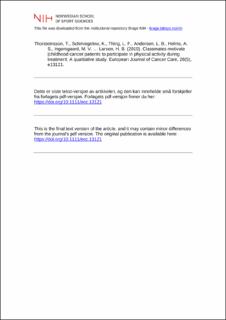| dc.contributor.author | Thorsteinsson, Troels | |
| dc.contributor.author | Schmiegelow, Kjeld | |
| dc.contributor.author | Thing, Lone Friis | |
| dc.contributor.author | Andersen, Lars Bo | |
| dc.contributor.author | Helms, Anne Sofie | |
| dc.contributor.author | Ingersgaard, Marianne Vie | |
| dc.contributor.author | Lindgren, Lea Hjortshøj | |
| dc.contributor.author | Larsen, Hanne Bækgaard | |
| dc.date.accessioned | 2020-06-24T09:18:15Z | |
| dc.date.available | 2020-06-24T09:18:15Z | |
| dc.date.created | 2019-08-22T15:04:41Z | |
| dc.date.issued | 2019 | |
| dc.identifier.citation | European Journal of Cancer Care. 2019, 28(5), e13121. | en_US |
| dc.identifier.issn | 0961-5423 | |
| dc.identifier.uri | https://hdl.handle.net/11250/2659264 | |
| dc.description | I Brage finner du siste tekst-versjon av artikkelen, og den kan inneholde ubetydelige forskjeller fra forlagets pdf-versjon. Forlagets pdf-versjon finner du på onlinelibrary.wiley.com / In Brage you'll find the final text version of the article, and it may contain insignificant differences from the journal's pdf version. The definitive version is available at onlinelibrary.wiley.com. | en_US |
| dc.description.abstract | Introduction Children with cancer experience reduced physical fitness and compromised social relationships during and following intensive treatment. This may negatively impact their quality of life. As part of the RESPECT study, we explored the motivations for participation in a physical activity programme during treatment. Methods Thirteen semi‐structured interviews were conducted with seven boys and six girls, diagnosed with paediatric cancer in 2013 and treated with chemotherapy (age 8–16 years; time from diagnosis to interview 6–16 months). Interviews were conducted in the children's homes. Results The qualitative analysis showed that children's motivations for engaging in the physical activity programme during intensive medical treatment were primarily influenced by (a) opportunity for physical activity with a classmate; (b) participation in group physical activity sessions; (c) support from significant others; and (d) improvement of physical well‐being. Main barriers included (a) poor physical well‐being; (b) compliance with medical procedures and being treated in protective isolation; and (c) limited physical activity facilities. Conclusion Despite barriers, it is possible to motivate and engage children with cancer in physical activity during intensive treatment in a paediatric oncology ward. Physical exercise and activity should be recommended and promoted from diagnosis throughout the treatment period and should include psychosocial and professional support. | en_US |
| dc.language.iso | eng | en_US |
| dc.subject | cancer | en_US |
| dc.subject | exercise | en_US |
| dc.subject | intervention | en_US |
| dc.subject | motivation | en_US |
| dc.subject | paediatric oncology | en_US |
| dc.subject | rehabilitation | en_US |
| dc.title | Classmates motivate childhood cancer patients to participate in physical activity during treatment: A qualitative study | en_US |
| dc.type | Peer reviewed | en_US |
| dc.type | Journal article | en_US |
| dc.description.version | acceptedVersion | en_US |
| dc.source.journal | European Journal of Cancer Care | en_US |
| dc.identifier.doi | 10.1111/ecc.13121 | |
| dc.identifier.cristin | 1718095 | |
| dc.description.localcode | Seksjon for idrettsmedisinske fag / Department of Sports Medicine | en_US |
| cristin.ispublished | true | |
| cristin.fulltext | postprint | |
| cristin.qualitycode | 1 | |
